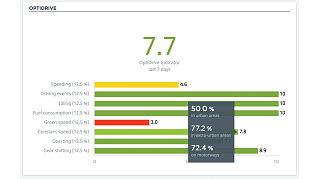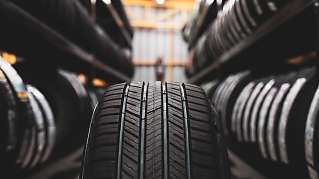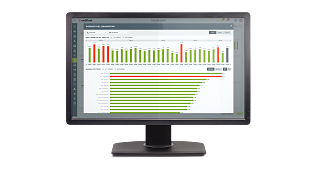The 5 Factors that drive up truck fuel costs
And what you can do to stop them








The factors that drive up truck fuel costs and what you can do to stop them
In Webfleet research, when fleet managers were asked to name the top issues they most wanted help with, reducing fuel costs ranked number one.
So, what’s driving up your fuel costs? In this extract from Cutting Transport Fleet Costs, the recent report from Webfleet and Bridgestone, we break down some of the main factors and the technologies you can adopt to help reduce the impact.
DRIVING BEHAVIOUR
From unnecessary acceleration and deceleration to idling to harsh braking, there’s a long list of inefficient driving habits that can see your trucks consume more fuel than they should.
A fleet management solution like Webfleet gives you access to a range of data points, creating complete visibility over how your drivers perform behind the wheel.
With valuable insights on things like speeding, driving events, idling, fuel, constant speed, coasting, green speed and gear shift, you can zero in on bad habits that eat up unnecessary fuel and take action to stop them.


TYRE PRESSURE
Slow leaks in tyre pressure or poorly maintained tyre pressure add up over time to increase fuel consumption. For example, 20% under-inflation increases rolling resistance enough to translate into a 2.5% increase in fuel consumption.
A tyre pressure monitoring system digitses and automates the entire process of checking and monitoring tyre pressure. It utilises sensors that identify tyre pressure and temperature issues from one or all of a vehicle’s tyres.
With Webfleet Tyre Pressure Monitoring System (TPMS), this information is then sent to the Webfleet Telematics Service Platform, which alerts the fleet manager in the office and the driver in the cab in real time. That way, you can take the necessary steps to stop a pressure issue evolving into a costly problem.
MILEAGE
Unnecessary kilometres driven translate to unnecessary fuel consumed. Inefficient route planning and unexpected traffic don’t just lead to a less efficient workflow. They also drive up your fuel costs.
Even the best driver can end up using more fuel than is necessary if they are on the wrong route.
The professional truck navigation of the PRO Driver Terminal series from Webfleet shows large vehicle drivers the most suitable routes for them, so there’s less chance of driving unnecessary kilometres.
It also offers access to up-to-date traffic information to keep you out of traffic jams where idling can increase fuel consumption.

TYRE ROLLING RESISTANCE
The more resistance your vehicle shows to movement, the more fuel it demands to be driven. So, a tyre with high rolling resistance will increase the quantity of fuel needed by your truck.
Having the right tyre on your vehicle can make all the difference when it comes to reducing cost. For example, the rolling resistance and mileage performance of the Bridgestone Duravis R002 delivers a fuel saving potential of up to 5% compared to the previous generation.
Even more fuel can be saved with the Bridgestone Ecopia H002, long haul tyres featuring A grade rolling resistance on every axle position. Given that one label grade corresponds to 5% fuel saving potential, Ecopia tyres can bring savings that exceed the actual tyre costs.
LACK OF INSIGHT
For a fleet manager, trying to pin down how fuel is being used and where it is being wasted is key to reducing cost. Yet trying to manually track fuel consumption across an entire truck fleet is a time-consuming, complex task. Is there a more efficient way to get this insight?
A fleet management solution like Webfleet allows you to monitor how fuel is being consumed in real-time and analyse historical fuel usage to improve going forward.
Not only can you compare how fuel is used over time, but also spot exceptional events, trends and anomalies and use these insights to optimise fuel usage and operational costs.

Talk to a specialist
Your consent is required
In this section, external content is being embedded from.
To display the content, your consent is required for the following cookie categories:
- Targeted Advertising
- Analytics & Personalization
- Essential
For further details, please refer to our privacy policy.If you are interested in how ###vendor_name### processes your data, please visit their privacy policy.








